Trans Dinarica is the first cycle route covering eight Balkan countries, stretching over 5,500 km through Slovenia, Croatia, Bosnia and Herzegovina, Serbia, Kosovo, Montenegro, North Macedonia, and Albania. It was launched in July 2024 and was quickly named one of the best places to visit in 2024 by CNN and other prominent media outlets.
As soon as I heard about the launch of Trans Dinarica, I knew I had to test it out. The Balkans are my favourite region for cycling, and I was excited to pedal across the mountains and follow an established route without worrying if the road I am choosing is ridable and safe.
I cycled a section of Trans Dinarica from Podgorica to Sarajevo. I can confidently call it one of the best cycling routes I’ve ever done.
In this article, I gathered answers to questions about this route and practical advice to help you plan your Trans Dinarica adventure.
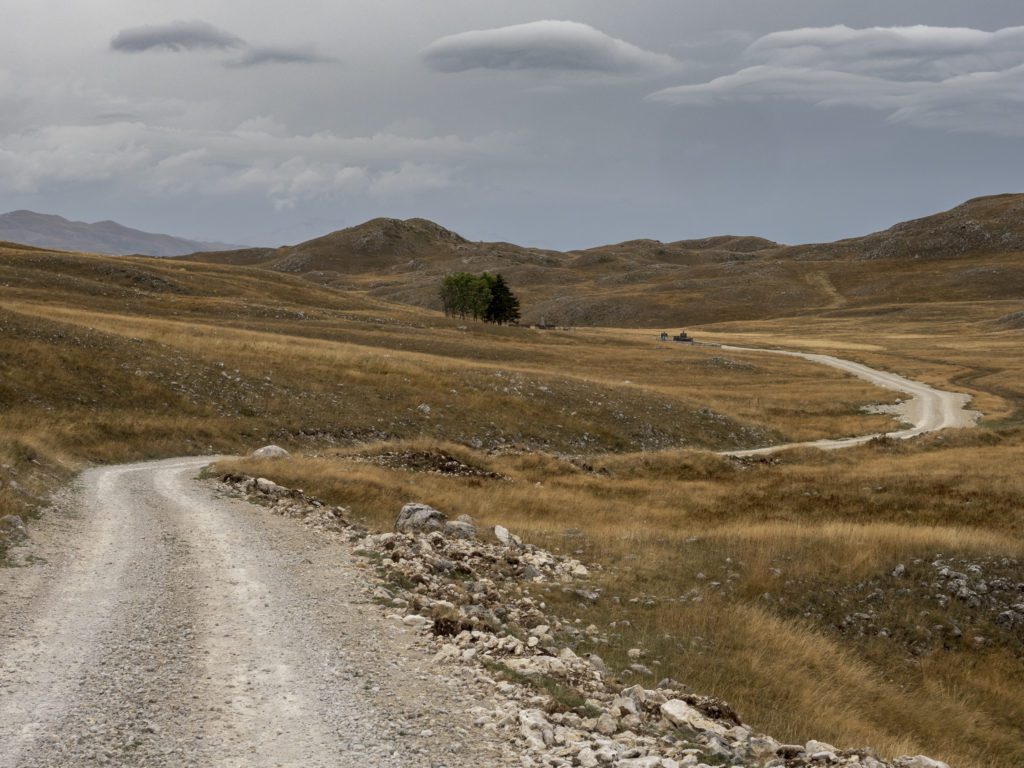
Why should you cycle the Trans Dinarica?
What makes the Trans Dinarica stand out among hundreds of long-distance cycling routes in Europe is its scenic diversity and wild nature. The Balkans are one of the last regions in Europe where you can experience peace and solitude in genuinely remote areas far from the crowds of tourists.
But you won’t be bored for a second. The landscape on the Trans Dinarica trail changes constantly, from alpine landscapes to dramatic coastal roads, deep ancient lakes, untamed rivers and rugged mountain plains.
The Balkans also have a rich history. Along Trans Dinarica lie several UNESCO World Heritage Sites, such as the Old Bridge in Mostar, the Lake Ohrid region, Decani Monastery, and the Stari Ras Complex.

Cycling is also a great way to experience Balkan hospitality and openness firsthand. During my trips to the region, I was often invited to people’s homes for a coffee or given fresh vegetables from their gardens.
How hard is Trans Dinarica? Terrain and Challenges
Road type
About 80 % of the time, you’ll ride on asphalted roads, while 20 % of the route is unpaved. Usually, you can expect good-quality gravel roads that should be passable even on narrower tyres.
There are some shorter sections where you can expect harsher roads, with larger stones or uneven gravel. They are mostly market (with the “!” symbol) in the official navigation package.
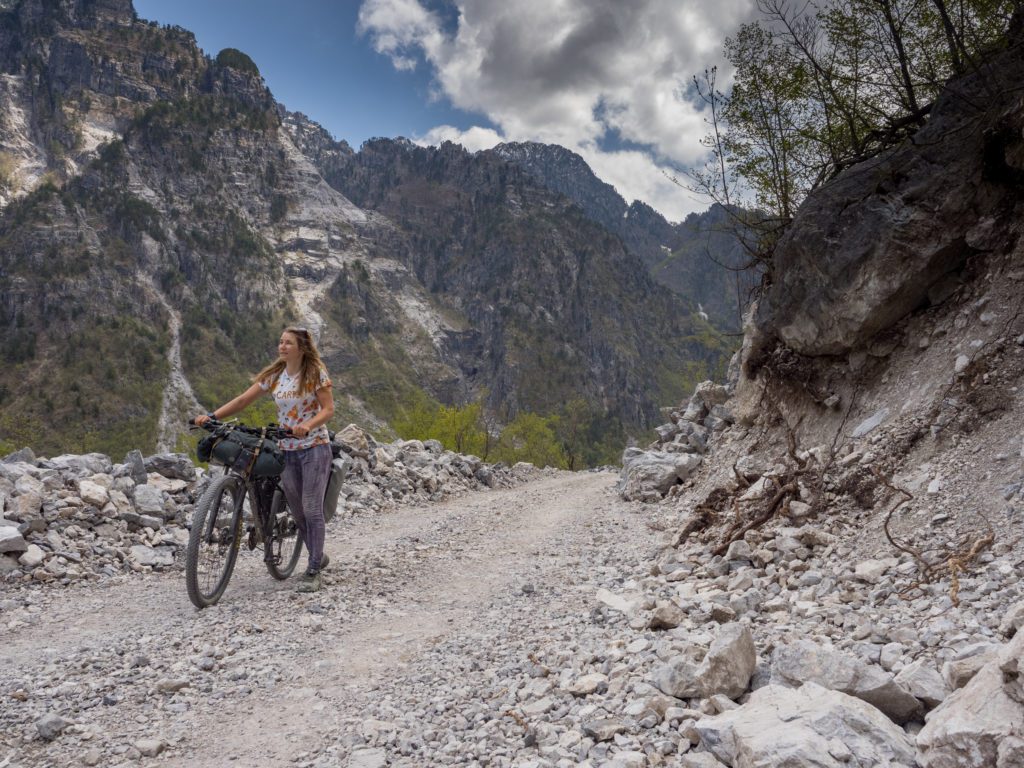
Elevation gain
Before embarking on the Trans Dinarica, be aware that the Balkans are very mountainous. Be prepared to climb 1000 meters per day regularly, sometimes more.
I cycled from Podgorica to Sarajevo in the opposite direction from the original route, and some stages had 1800 m of elevation on less than 70 km.
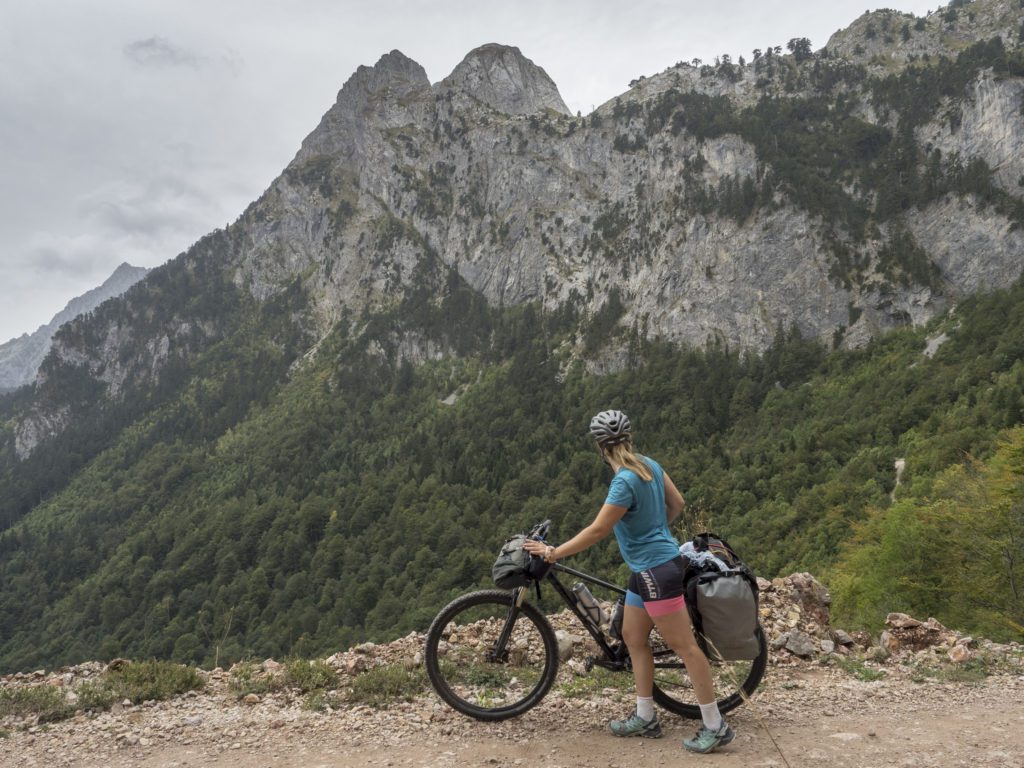
When choosing which part of Trans Dinarica to cycle, check the elevation profile for particular stages. Some sections are slightly less demanding (for example, the main route in Slovenia and most of the stages in North Macedonia in Kosovo).
Cycling Trans Dinarica is a challenge and demands a good fitness level. But don’t be discouraged! If you’re not a great climber, you can always hike a bike on some of the steeper ascents.
The weather. When is the best time to cycle Trans Dinarica?
The best time to cycle the Trans Dinarica is generally from May to September. However, the weather varies considerably. While it can be scorching hot on the Adriatic coast, there can still be snow high in the mountains.
Parts of the route, especially the lower sections in Albania, Macedonia and Croatia, are better for spring or early autumn cycling. In the Summer, you might face sweltering temperatures that make cycling unbearable. It’s better to stay as high in the mountains as possible at that time. July and August are much better for cycling through Durmitor and the Bosnian mountains.
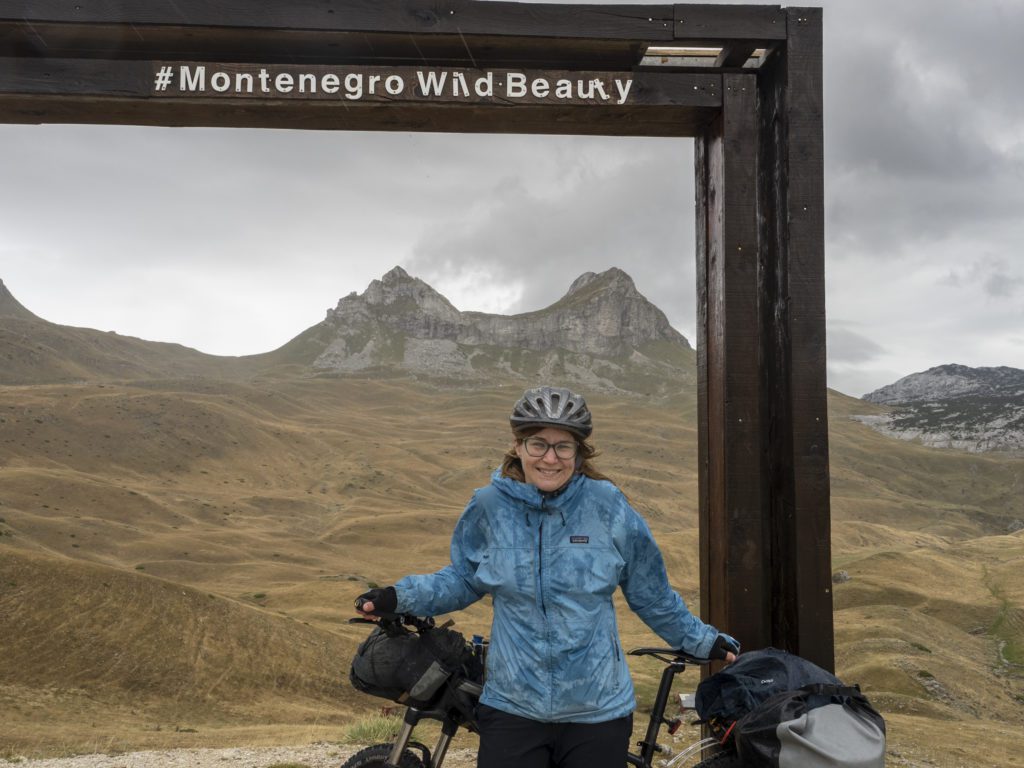
No matter when you plan to cycle Trans Dinarica, you should be prepared for all kinds of weather. Remember to pack a good rain jacket, long pants, sunscreen and gloves (your hands will thank you on long descents on colder days).
The gear. What bike is best for Trans Dinarica?
As mentioned earlier, 80 % of the route is on paved roads. That means that the Trans Dinarica can be cycled on almost any bike. The best options are gravel, touring, hybrid, and hardtail mountain bikes.
Do you want to do the Trans Dinarica on a road bike? If you plan carefully, you can pick some sections that are mostly asphalted. The best countries would be Montenegro and Kosovo, where over 90 % of the route is paved.
It is possible to cycle Trans Dinarica on a fully loaded bike. However, remember that every kilogram of your luggage will feel extremely heavy on the steep and long climbs.
Don’t overpack. The lighter your bike, the more joy you’ll have from roaming across the Dinaric Alps.
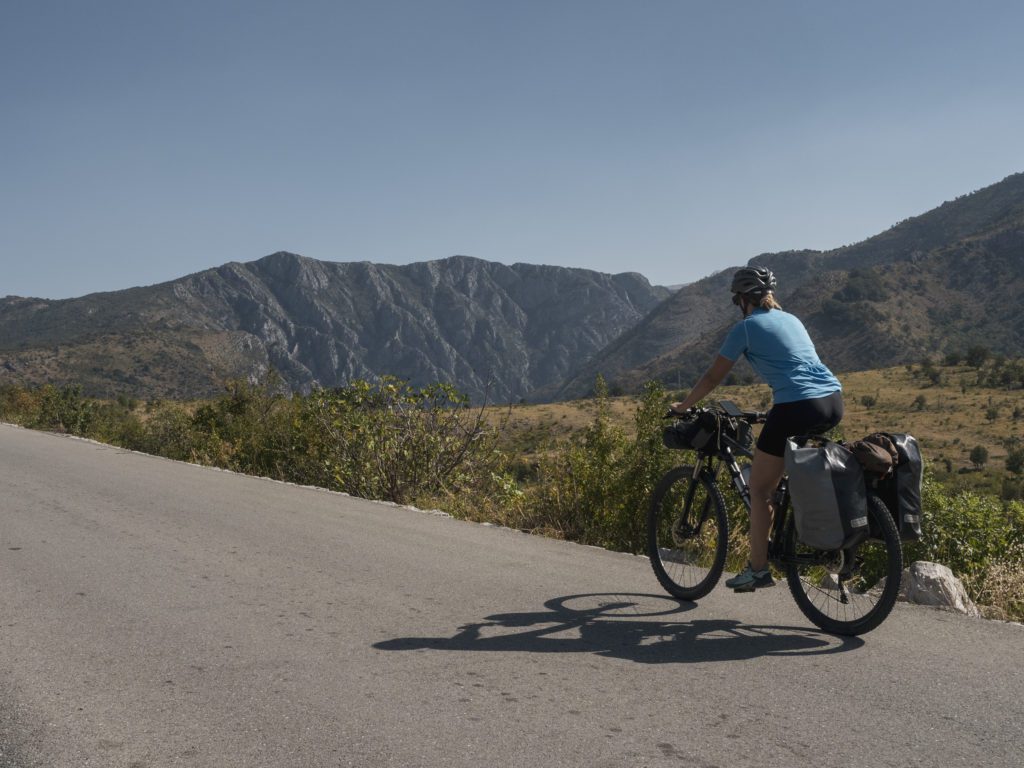
The Trans Dinarica route isn’t signposted or marked. The route only exists in a digital form, and you’ll need a map or the navigation package to navigate.
The official website provides a free general map of every stage in PDF format. This map should be enough to navigate the route roughly.
You need to purchase a navigation package for each country to access more route details, including the POIs and a GPS file. Then, you can navigate using the Ride with GPS app, download the GPS file, and upload it to your preferred navigation app or device.
The GPS track in the Ride with GPS app is available offline, so you don’t need to worry about internet access.
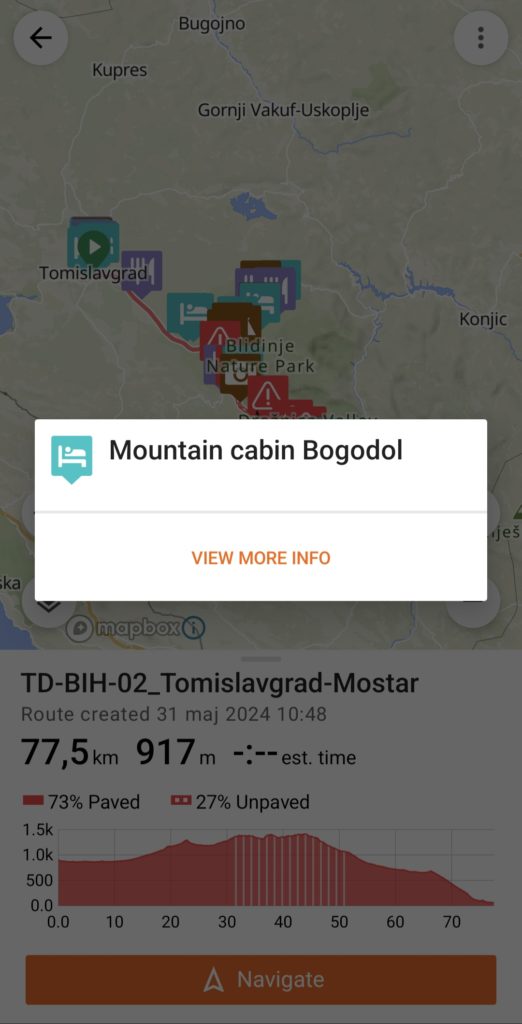
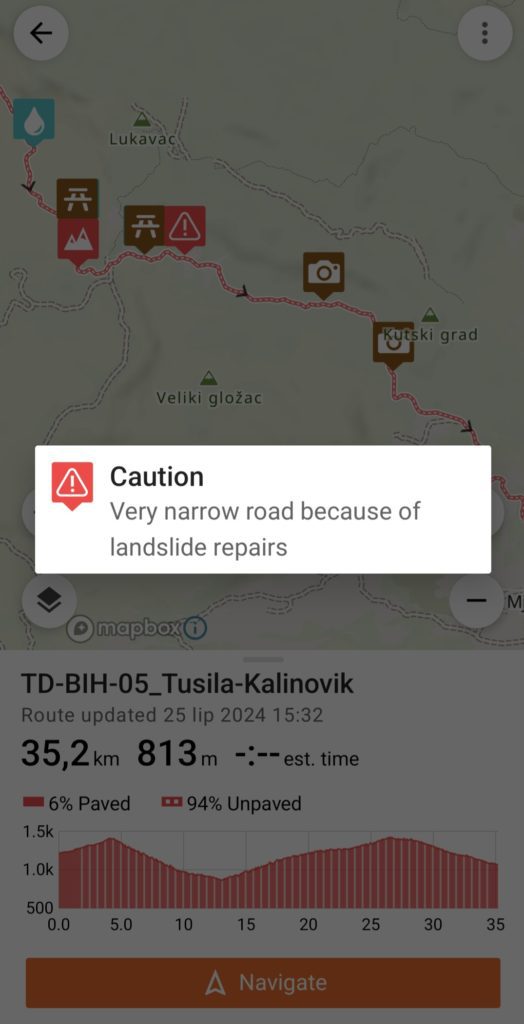
The navigation pack for all countries costs 176 euros. However, you can buy the navigation pack for the countries you plan to cycle. Prices differ depending on the number of stages within a country (it costs only 16 euros for Kosovo up to 46 euros in Albania).
It might seem expensive. But remember that, in addition to the convenience of having an accurate GPS track with valuable points of interest and warnings about challenges along the route, you’re also supporting community-based and sustainable tourism in the Balkan region.
When cycling through Bosnia and Montenegro, I encountered some issues with the Ride with GPS app. To access the GPS track, you must scan the QR codes you’ll receive after purchasing the navigation pack. However, the downloaded route disappeared from the app at one point. Luckily, I stored the QR codes on another device and could scan them again.
I am unsure if this is a common issue or if I was the only one experiencing it. Print out the QR codes or download them onto another device to avoid being left without navigation.
Alternatively, you can download the GPS files and open them later in any navigation app.
Where to stay along Trans Dinarica
Camping
The Balkans are a perfect place for camping. Sleeping in your tent immerses you in the stunning landscape even more. Some of my best wild camping spots were in the mountains of Albania and North Macedonia.
You can legally wild camp in Albania, Kosovo, North Macedonia, Serbia and Bosnia and Herzegovina (in Bosnia, you need to be aware of the landmines – usually, the mine-contaminated areas are marked with a red sign with a skull and crossbones). It is technically not allowed in Montenegro and Croatia. Still, you shouldn’t have any problems if you don’t do it on beaches, national parks or private property. The rules are stricter in Slovenia. Remember to leave no trace and be respectful towards nature.
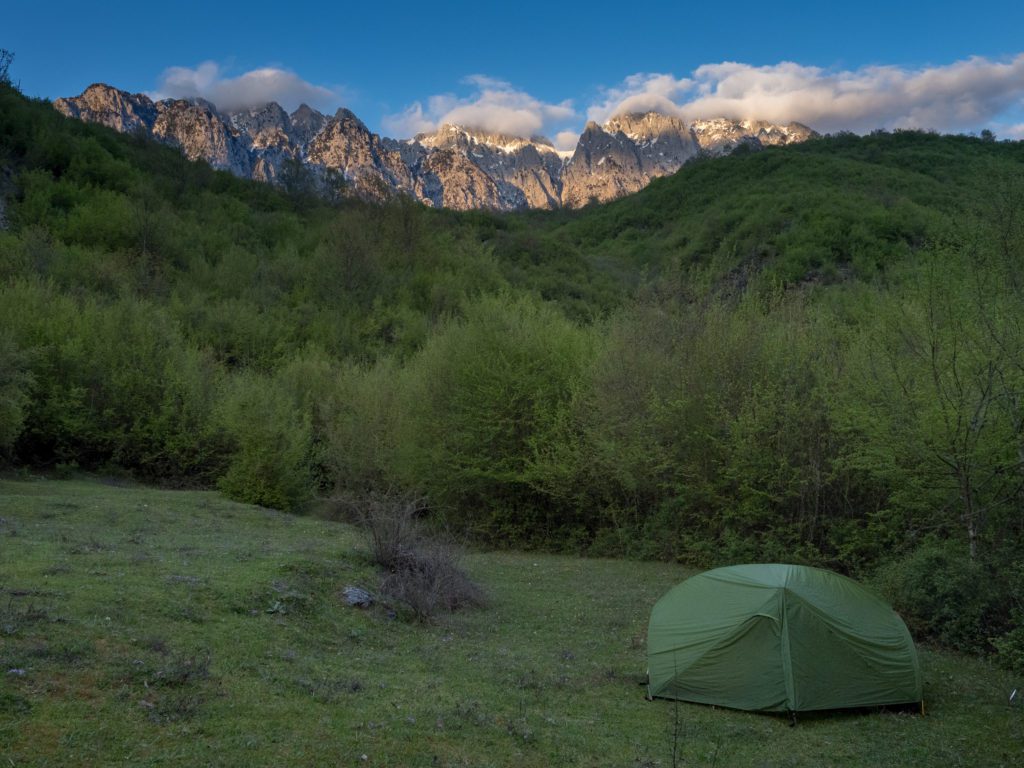
There are also plenty of campsites along the route, with reasonable prices ranging from 5 to 15 euros per person.
Guesthouses, hotels and hostels
From my experience, finding accommodation along the route is easy and affordable. If you plan it well, it is definitely possible to cycle Trans Dinarica without carrying camping gear.
Usually, the navigation app marks some guesthouses or hotels at the end of each stage, making planning much more straightforward.
Through years of bike trips in the Balkans, I never had to book my accommodation beforehand. I typically use booking.com to find a place to stay.
The prices for guesthouses and hotels are low (Slovenia and Croatia are the most expensive countries along the route). In Albania and North Macedonia, you can find a dorm bed for as little as 7 euros or a private room for 15 euros.
Food and water
Food
While some of the sections of Trans Dinarica lead through wild and remote landscapes, you’ll find a grocery store at least every other day (the stores are marked on the official map). You should always have enough snacks to get you through the day, and if you’re wild camping and cooking on your own, resupply whenever you have a chance.
If you’re not carrying a camping stove, you’ll have many opportunities to try the local Balkan cuisine. Along most Trans Dinarica stages, there are some small restaurants where you can taste local delicacies such as grilled meat, dolma, or bean stew.
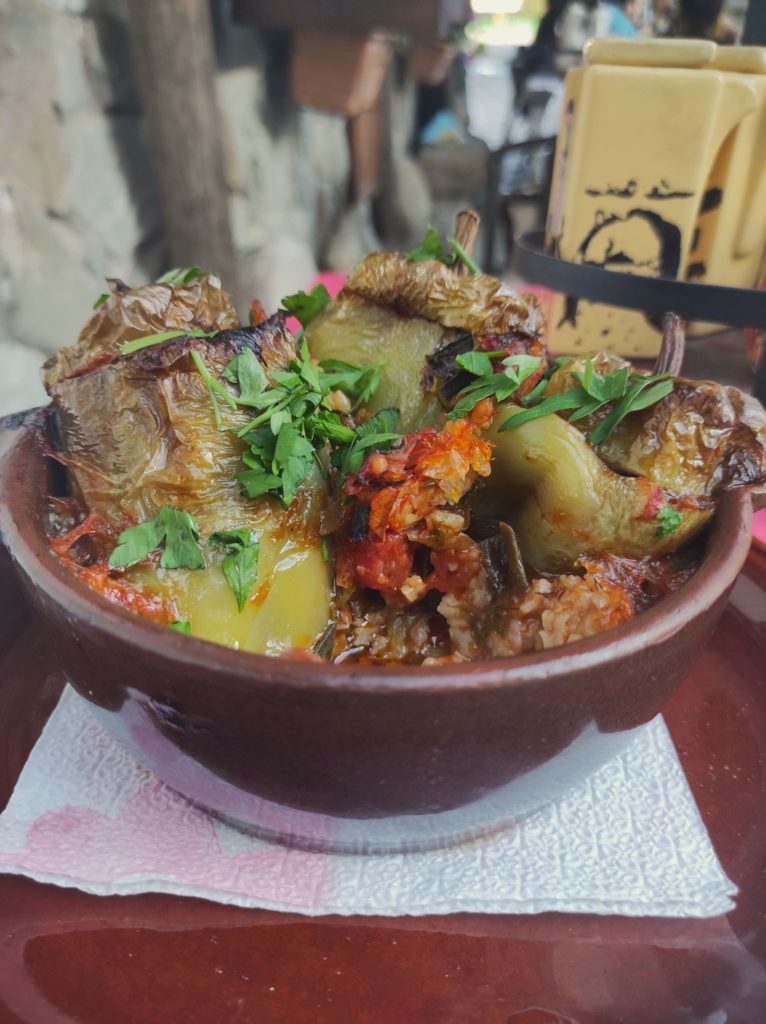
Balkan cuisine is traditionally very meat-based, but as a vegetarian, I was always offered some meat-free alternatives, such as grilled vegetables, cheese, or, worst case, shopska salad with cheese.
My go-to snack for long rides in the Balkans is burek, a filo pastry pie filled with cheese or spinach.
The biggest surprise on my latest Trans Dinarica tour was the wide range of vegetarian options at Dom Vrela, a mountain cabin in Bosnian Tusila. If you’re vegetarian or vegan, you should stop there and taste their amazing vegetarian dolma!
Water
Tap water is generally safe in most Balkan countries, except for some cities like Tirana (my friend had pretty bad stomach issues after drinking tap water there).
On the roadside, you’ll often find water fountains where the water is generally safe to drink.
If you have a sensitive stomach and don’t want to risk any issues, consider carrying a good water filter, such as Life Straw or Sawyer.
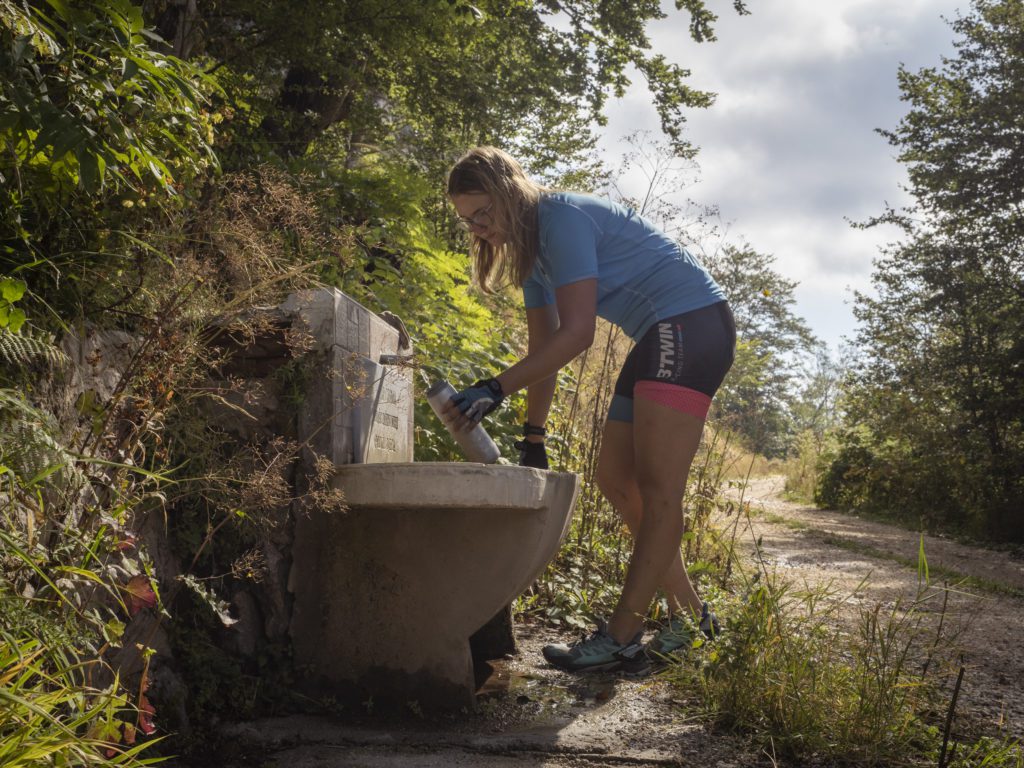
Safety Tips
Road safety
For the most part, Trans Dinarica leads on secondary country roads and dirt roads with little traffic. There are some short sections on busier roads (usually marked in the official GPS track) where you should be extra cautious. In many Balkan cities, there is no separate cycling infrastructure.
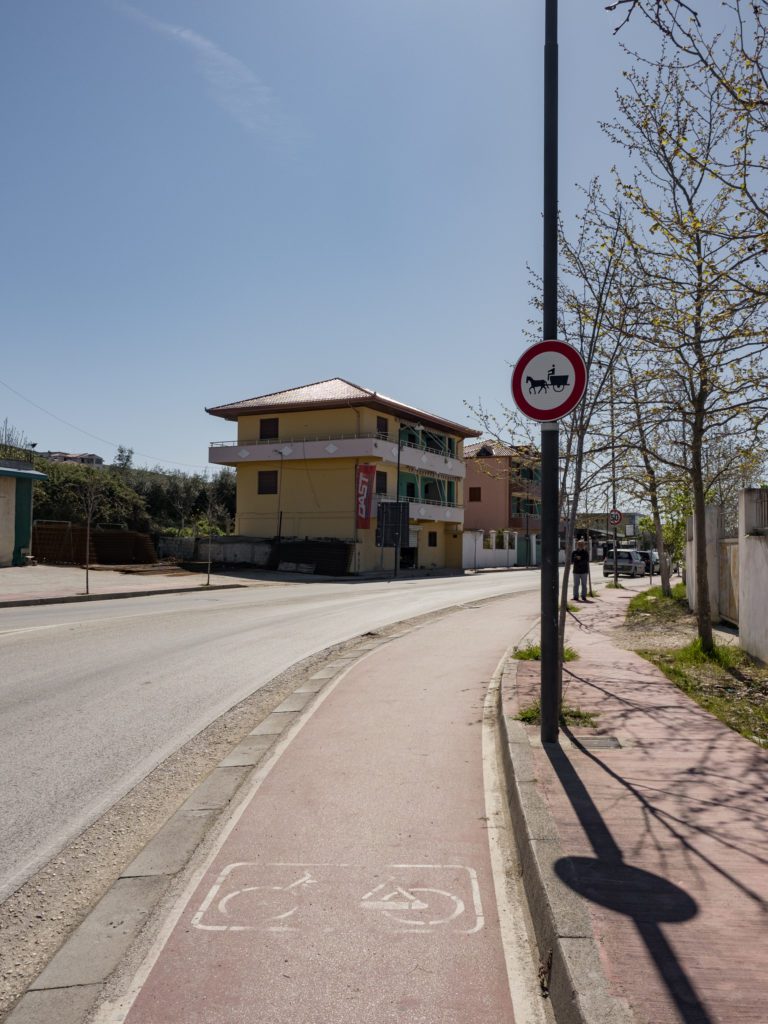
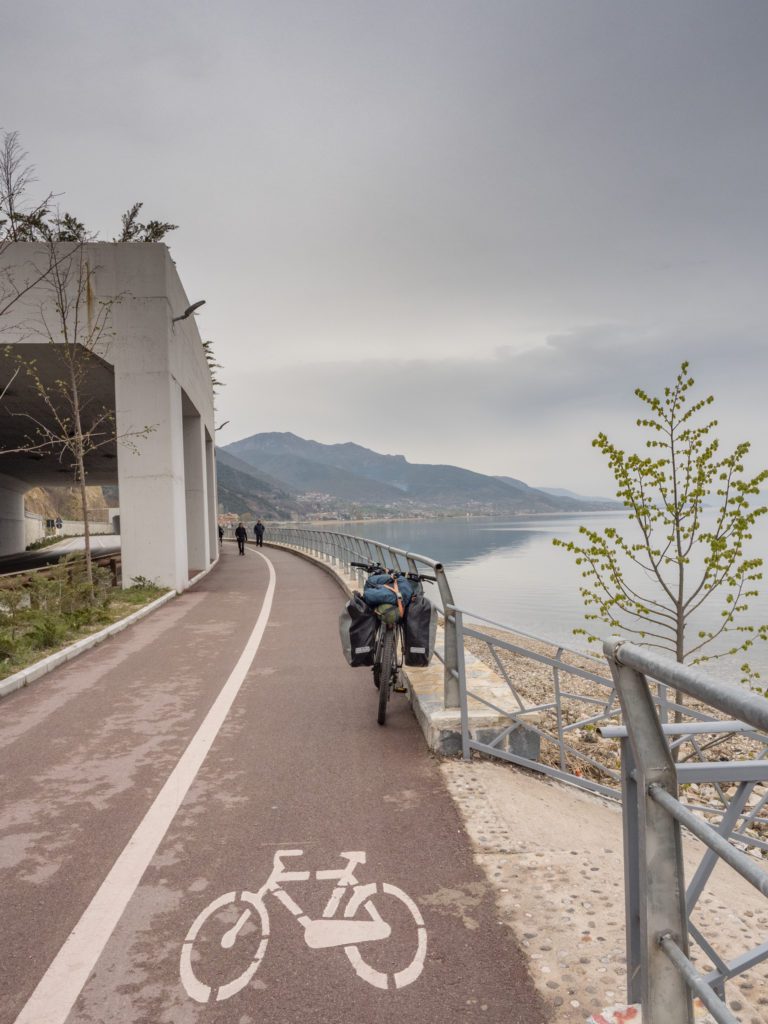
Sometimes, the roads have no shoulder, and drivers still overtake cyclists without leaving a safe distance. Keep at least 0.5 metres from the curb edge for extra space and to avoid close calls.
Don’t forget good bicycle lights and high-visibility clothes. They will increase your safety in bad weather.
Mechanical issues and repairs
Before embarking on the Trans Dinarica route, ensure your bicycle is in top condition. Replace the brake pads (you’ll need them on the long descents) and give it a solid check-up to avoid grappling with mechanical issues somewhere in the middle of nowhere.
There are some bicycle repair shops along the Trans Dinarica (marked in the navigation package), usually in the major cities. Sometimes, you have to ride a few hundred kilometres before reaching one.
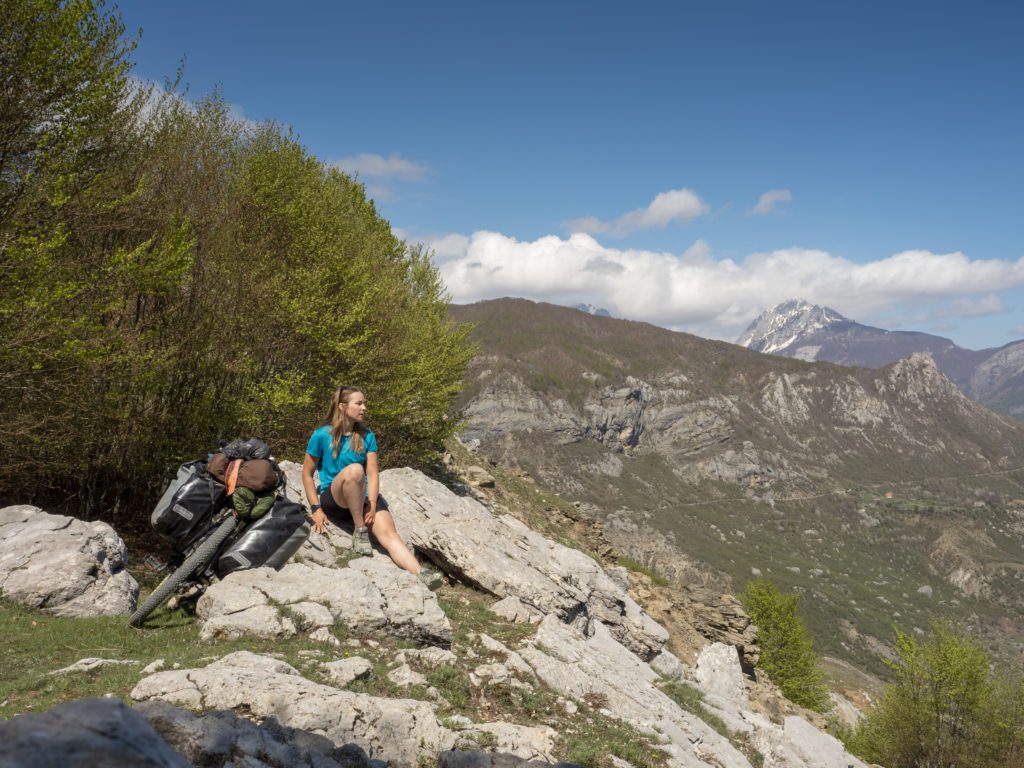
That’s why you need to bring the essential tools and spare parts. I usually carry:
– a spare inner tube
– inner tube patches
– a multitool with keys for all the screws and bolts in my bike
– spare brake pads
– zip ties and duct tape (a duo that can temporarily fix everything from a broken luggage rack to a saddle).
Personal safety
I have often cycled solo in the Balkans and felt very safe. However, remember that some parts of Trans Dinarica are pretty remote and in desolate mountain areas. Whether travelling alone or as a group, you should take several safety precautions.
– Keep your phone charged. Ensure your mobile phone has enough battery to call for help if you encounter problems. Get a local SIM card or an eSIM card (I used Airalo last time. You can also check out Yesim’s Balkan package) to get some mobile data. Prepare for not having a signal in some of the most remote areas.
– Check the weather, especially before the most mountainous stages. Heavy rain combined with low temperatures high in the mountains can be really punishing. You also want to avoid being caught by thunderstorms or wind in a place where there is nowhere to hide. Be prepared to adjust your plans in case of extreme weather.
– Bring solid waterproof clothing.
– Remember to drink enough water and electrolytes and, in case of the heat, hit the trail early in the morning to avoid cycling when the sun is burning.
Wild animals and dogs
Plenty of wild animals live in the Dinaric Alps, although I never met a bear or a wolf during the many weeks I spent cycling there.
A few tips to keep you safe from bears include making noise (like talking or singing) when cycling in the evening and storing your food outside your tent (hanging on a tree) when wild camping.
If you meet a bear, don’t run. Slowly back off while remaining as calm as possible.
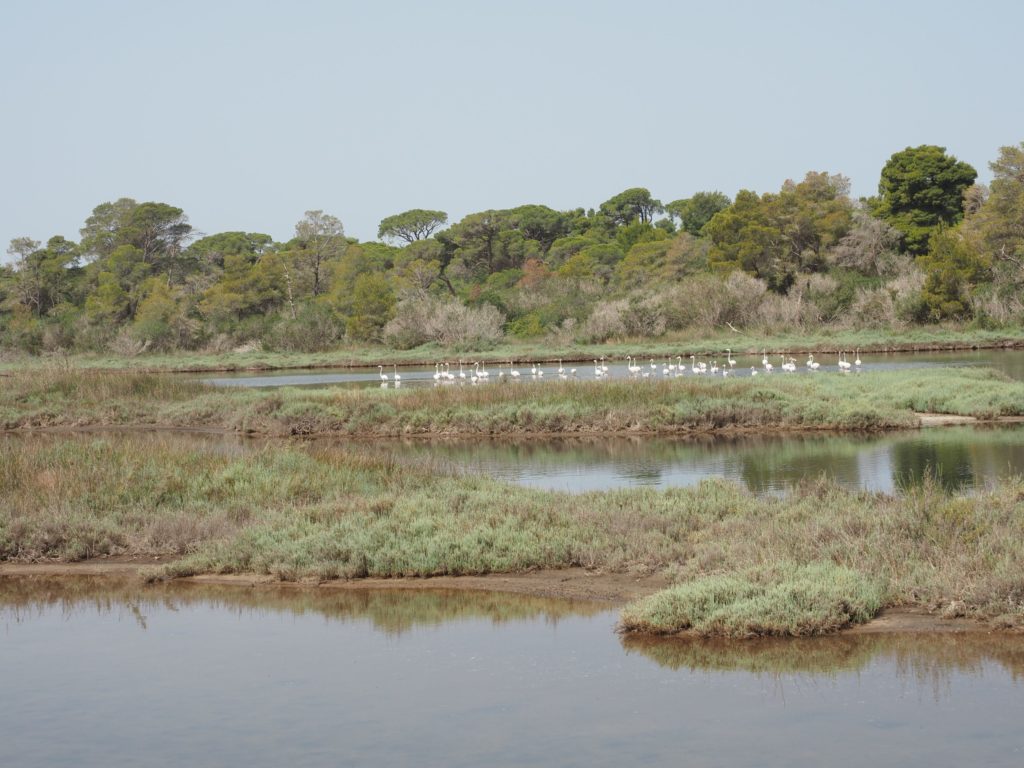
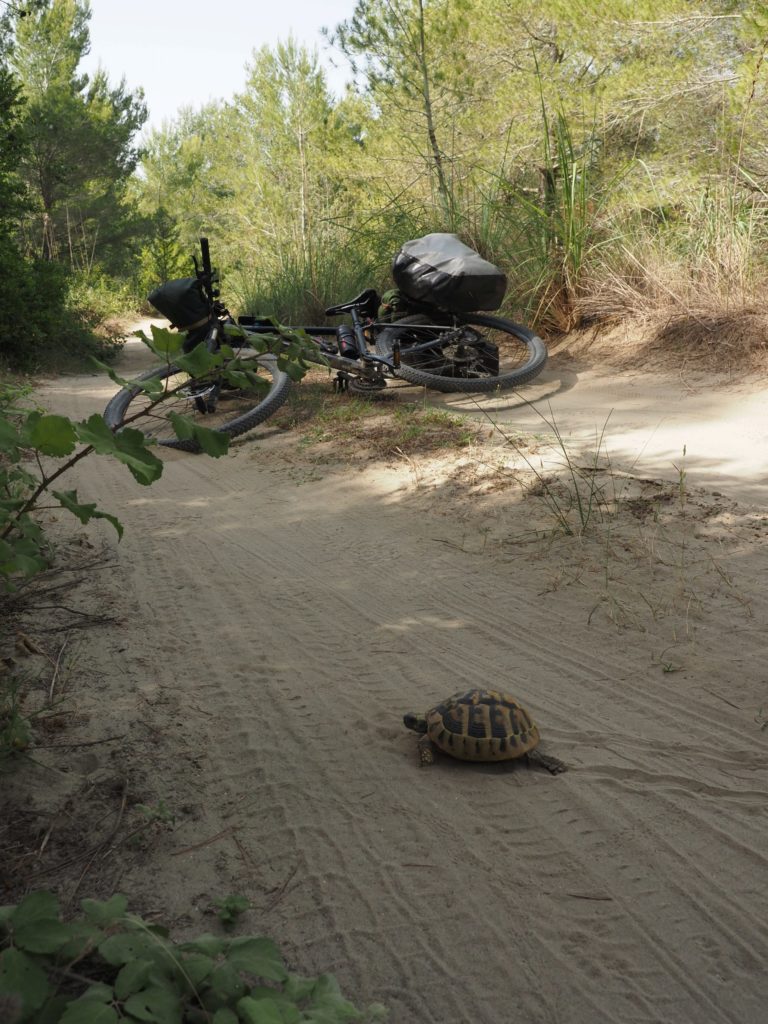
You are more likely to encounter stray dogs or shepherd dogs. Stray dogs are usually quite friendly, but shepherd dogs are protective of their territory and livestock and might start chasing you. I typically slow down, sometimes even getting off my bike. Then, I position my bike between me and the dog and slowly continue walking while calmly talking to the dog. If the dog is aggressive, splash water at him or throw rocks towards him (not at him).
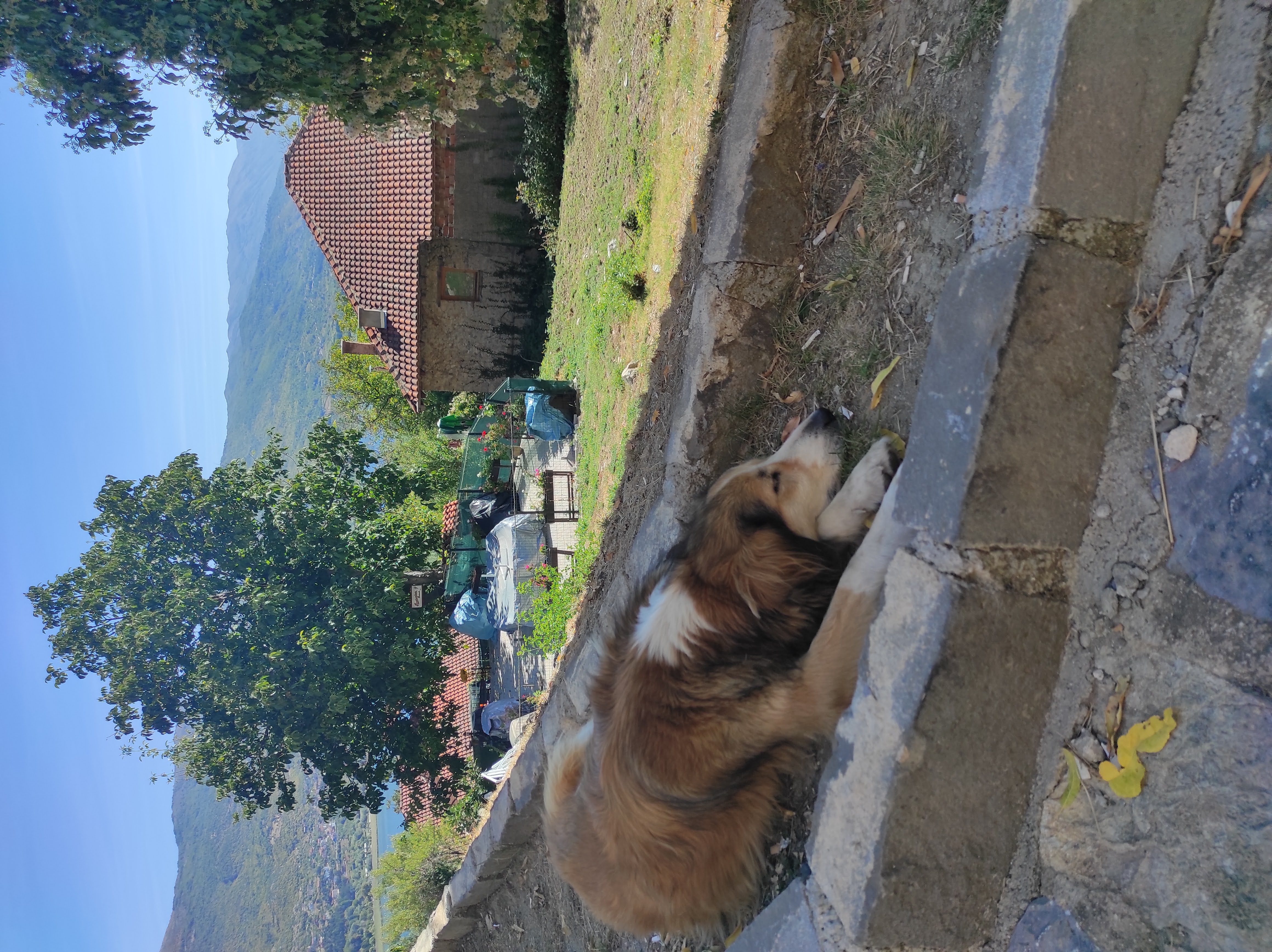
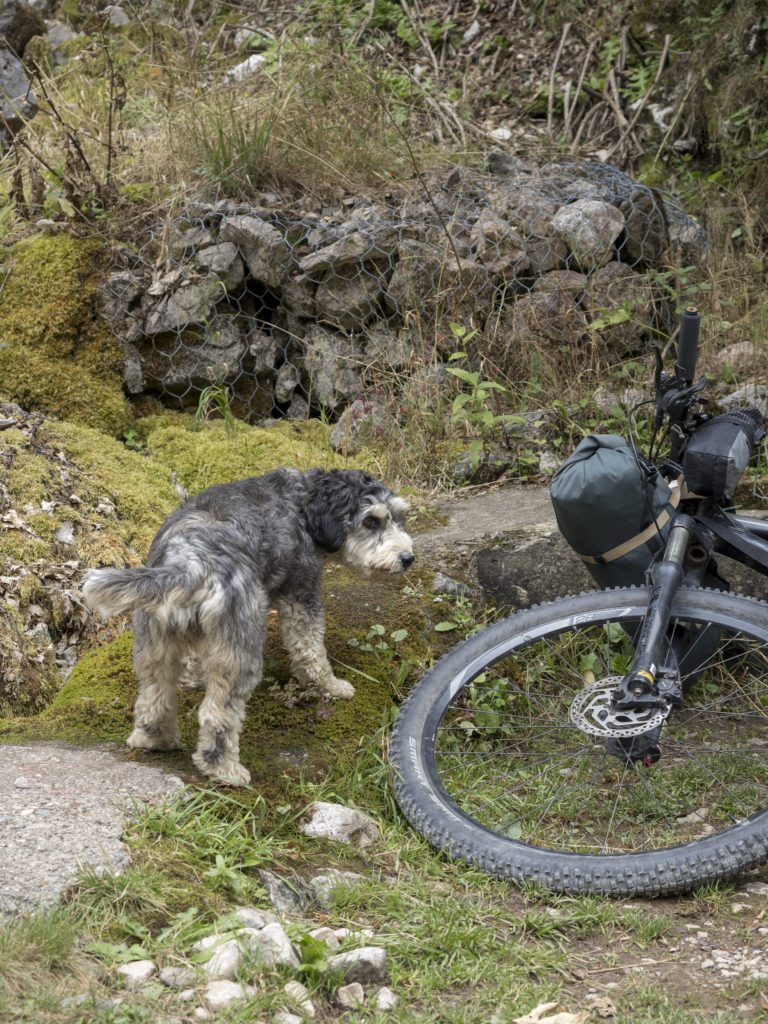
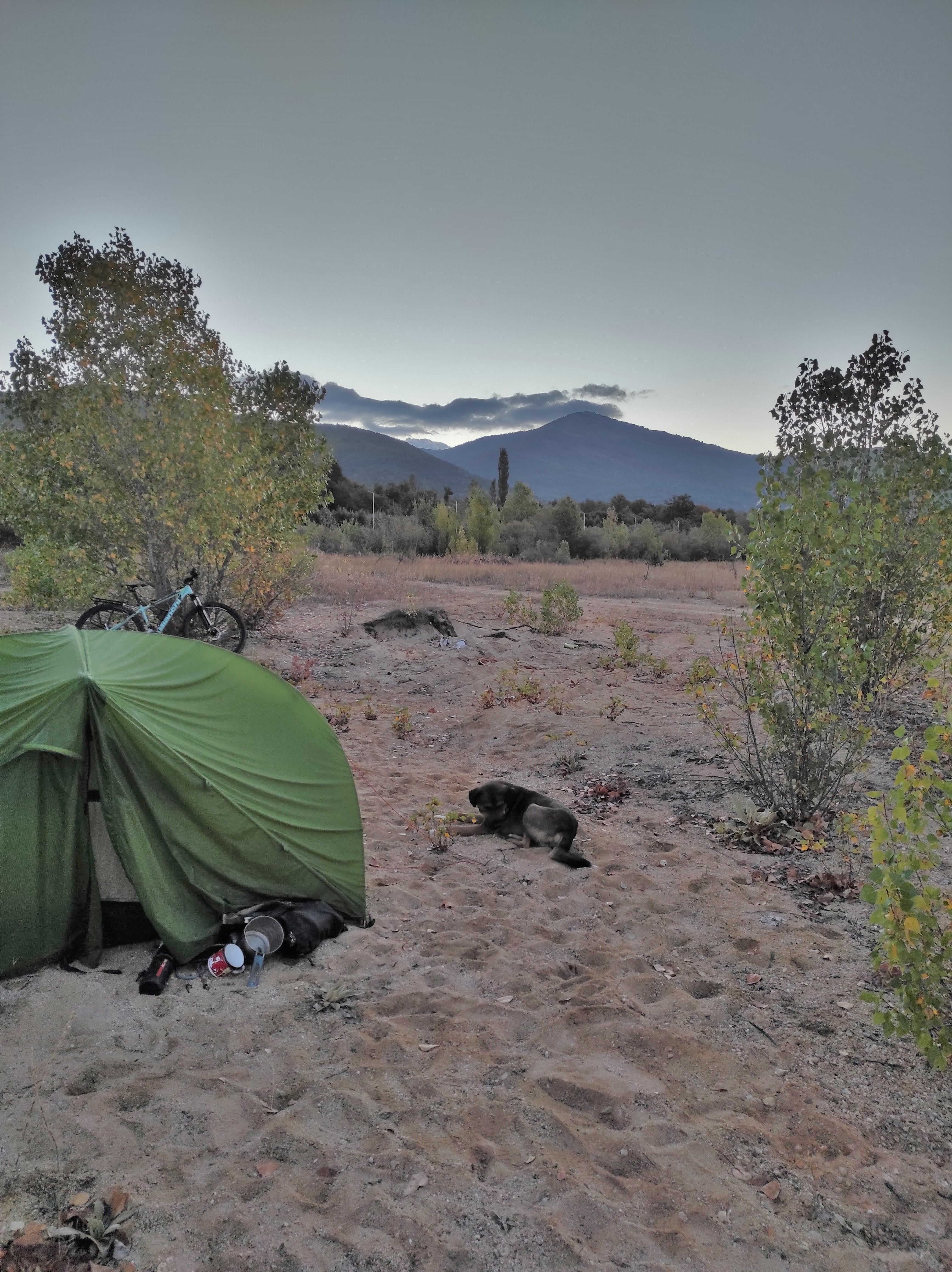
Logistics
Border crossings on the Trans Dinarica route
Trans Dinarica stretches through eight countries. Crossing the borders by bike is relatively unproblematic – you queue in the same line as the cars and pedal ahead after a passport check. There is no border check between Slovenia and Croatia, as both countries are within a Schengen zone.
If you’re a citizen of an EU country, you can enter all Trans Dinarica countries with a national ID.
If you’re a third-country national, check if you need a visa for any of the countries along the route.
Public transportation
Sometimes, you need to skip some stages and take public transportation. Here are some tips on doing it in all eight countries along the Trans Dinarica.
Albania
Albania’s railway network is outdated, with limited trains between cities like Tirana, Elbasan, and Durres on weekends. There are some bus connections between major cities, and taking your bike on a bus should be easy as long as there is space.
Bosnia and Herzegovina
The railway system here is sparse, with routes like Sarajevo–Banja Luka or Sarajevo–Mostar. Taking a bicycle often depends on the conductor’s discretion. You may not always get lucky, especially if the train is full.
Another option is buses, where you have to rely on the driver’s goodwill and available space.
Croatia
You can take your bicycle on a train in Croatia if your train has a special coach for bicycles. Croatian railways charge 1,99 euros for taking your bike. You can buy the ticket on a train or at the train station; it’s not possible to buy a bicycle ticket online.
I once took a train from Zagreb to Slavonski Brod. Theoretically, this train wasn’t suitable for bicycles, but nobody from the staff had any problems with it. It was hard to carry my bike up the narrow stairs, and the trip wasn’t super comfortable, as I had to sit with my bike in the corridor.
Kosovo
The rail system in Kosovo is somewhat underdeveloped. As the schedules change frequently, you should expect a fair share of unpredictability when using public transport in this country, whether a train or a bus.
Montenegro
You can take a bicycle on most trains in Montenegro. The bicycle ticket costs 4 euros.
It is not possible to book tickets online. You have to buy it at the train station.
You can find the timetables on Montenegrin Railways’ website.
North Macedonia
The policy of The Macedonian Railways regarding bicycles on trains is quite vague, and it’s hard to find any specific information about it.
According to Rante, a cycling guide from Skopje, bicycles can only be taken on trains with designated bicycle cars, which are rare. That means you shouldn’t have too high hopes about bringing your bicycle on a train in North Macedonia.
In July 2024, my reader Bozhidar informed me that the railway was in bad shape but that taking a bike on a train was still possible if the conductor was okay with it. It’s free of charge, but you’ll spend your journey holding your bicycle as there is no dedicated space for bicycles on most old trains.
Serbia
The majority of trains in Serbia are operated by the Serbian Railways. Many trains accept bicycles, but usually, there is space only for two bikes.
The bicycle ticket costs 100 dinars (ca. 0,85 euros). It is currently not possible to buy tickets online. You can find your connection on this website.
Slovenia
Slovenia has a more developed system where bicycles are allowed on many trains (marked with a bicycle icon in the timetable). A bicycle space costs 1,5 euros. However, to the best of my knowledge, it isn’t possible to book it online.
Staying connected
As a solo traveller, I always ensure I have a local SIM card or an eSIM card, as having a mobile connection is essential for my safety. Still, you need to be prepared that you won’t have cellphone reception in some of the most remote corners of the route (it’s rare but can happen). Always have your maps downloaded offline.
Suppose your Trans Dinarica adventure is limited to one country. In that case, you will be best off buying a physical local SIM card (if you have an EU SIM card and travel in Slovenia and Croatia, you won’t need one, as you can roam like at home).
In Albania, Montenegro and Bosnia, you can buy a SIM card with a lot of data for about 15 euros.
You can find more information in my bike touring guides.
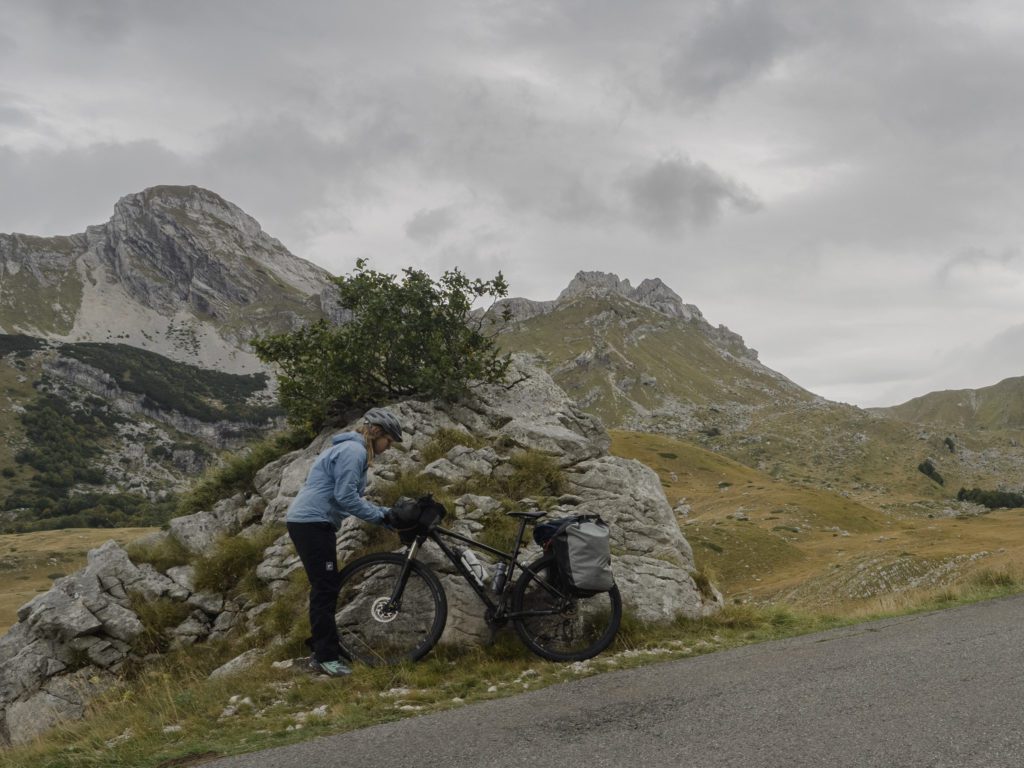
If you want to avoid bothering with too many physical SIM cards, an eSIM is a much more convenient option. You download an app, purchase a package and activate the card before arriving in the country.
Yesim offers a special Balkan package. You’ll pay just 15 euros for 30 days (with 5 GB of data) and avoid having to change the SIM card every time you cross the border.
Which part of Trans Dinarica should I choose if I want to make a loop?
Suppose you want your journey to finish at the same place where you started. In that case, there are several itineraries you can follow.
1. The Slovenia Circle: Tolmin – Ilirska Bistrica: 1 country, 6 stages, 289 km
2. The Croatia Circle: Senj – Zrmanja: 1 country, 7 stages, 370 km
3. The Bosnia and Herzegovina Circle: Livno – Sarajevo: 1 country, 11 stages, 540 km
4. Four-country Circuit: Bosnia and Herzegovina, Montenegro, Kosovo, Serbia: 4 countries, 23 stages, 1.092 km
5. The Accursed Mountain Circuit: Montenegro and Albania: 2 countries, 9 stages, 422 km
6. The Lake Circuit: Albania and North Macedonia: 2 countries, 15 stages, 832 km
7. The Dinarics-Sharr Circuit: Albania, North Macedonia, Kosovo: 3 countries, 19 stages, 1.036 km
How much time do I need to cycle Trans Dinarica?
The great thing about cycling Trans Dinarica is that you can choose between many suggested itineraries (or even create your own), depending on your time.
The total distance of all stages is over 5500 kilometres, including the secondary and alternative stages. If you want to cycle Trans Dinarica across all eight countries, you need at least a month.
The stages suggested in the itineraries are of reasonable length (between 30 and 80 km), but remember that you’ll regularly have to climb about 1000 m per day (sometimes much more).
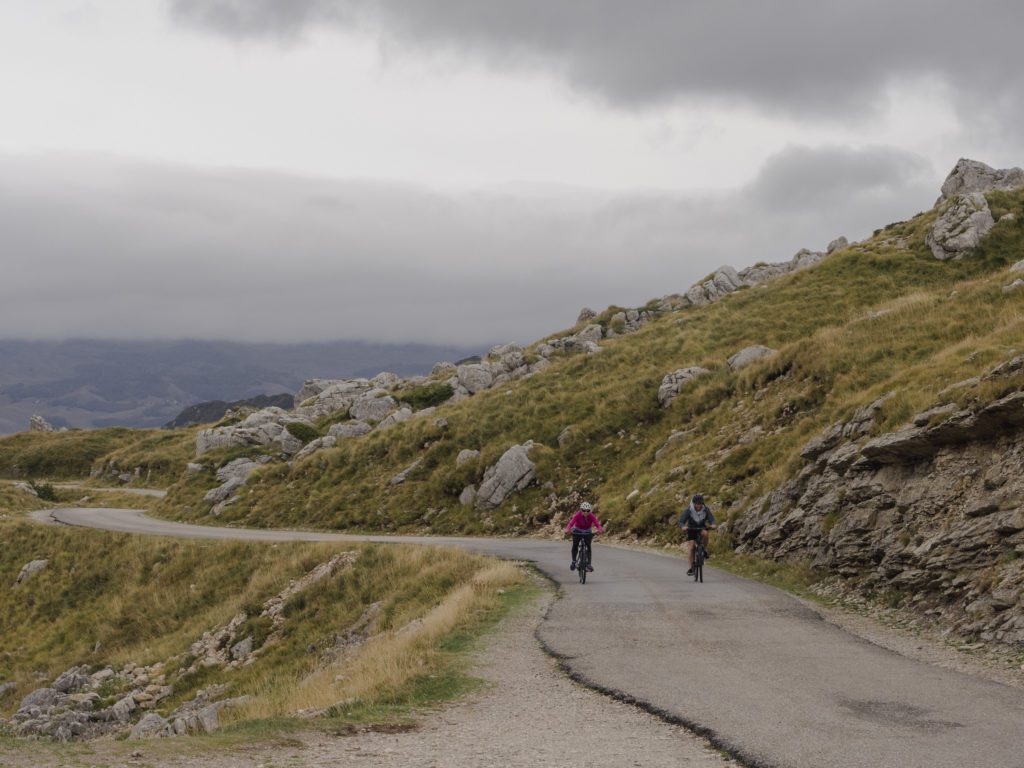
I felt comfortable with the stages between Podgorica and Sarajevo. However, there was much more elevation gain than in the original direction. Usually, I had enough time to take pictures, stop for food, socialize with the locals and other tourists, or enjoy my time outside in the evening.
Everyone’s pace is different, so I recommend adding extra days for rest or exploration. I also like flexibility in case of bad weather and external circumstances.
Money
Accommodation and food along the Trans Dinarica route are affordable by European standards. Prices are highest in Slovenia and Croatia and lowest in Albania and North Macedonia.
Since the route leads through some remote areas, don’t expect card payments to always be accepted. Check where you can find ATMs ahead of time, as there are not always many of them along the route. I made a mistake and didn’t do that after entering Bosnia. I ended up cycling all the way from the Montenegrin border to Sarajevo with just a 100 euros bill in my pocket, unable to find any ATM with the Bosnian Mark.
Many ATMs I found charged a fee of 3-6 euros for withdrawing money using a foreign card.
Currencies in Trans Dinarica countries:
Montenegro, Kosovo, Croatia, Slovenia – Euro
Bosnia and Herzegovina – Bosnian Mark (Euro is widely accepted)
Serbia – Dinar
Albania – Lek
North Macedonia – Denar
Most important tips on cycling Trans Dinarica
1. Don’t overpack. Keep your luggage as light as possible. Every kilogram will weigh you down on the climbs.
2. Be prepared for all kinds of weather. The route goes from sea level to almost 2000 metres. That means the weather and temperature can change rapidly in just a few kilometres. Pack a good rain jacket, some warm clothes, and sunscreen.
3. Follow the original direction of the route if you want to avoid doing extra climbs. I cycled in the reversed direction from Podgorica to Sarajevo and had some days with 1800 metres up.
4. Learn a few basic words in Serbo-Croatian and other languages of the countries you travel to. While most young people in the Balkans speak pretty good English, this is different for the older generation. Speaking at least some words in their language will help you socialize with the locals and enjoy their openness and hospitality.
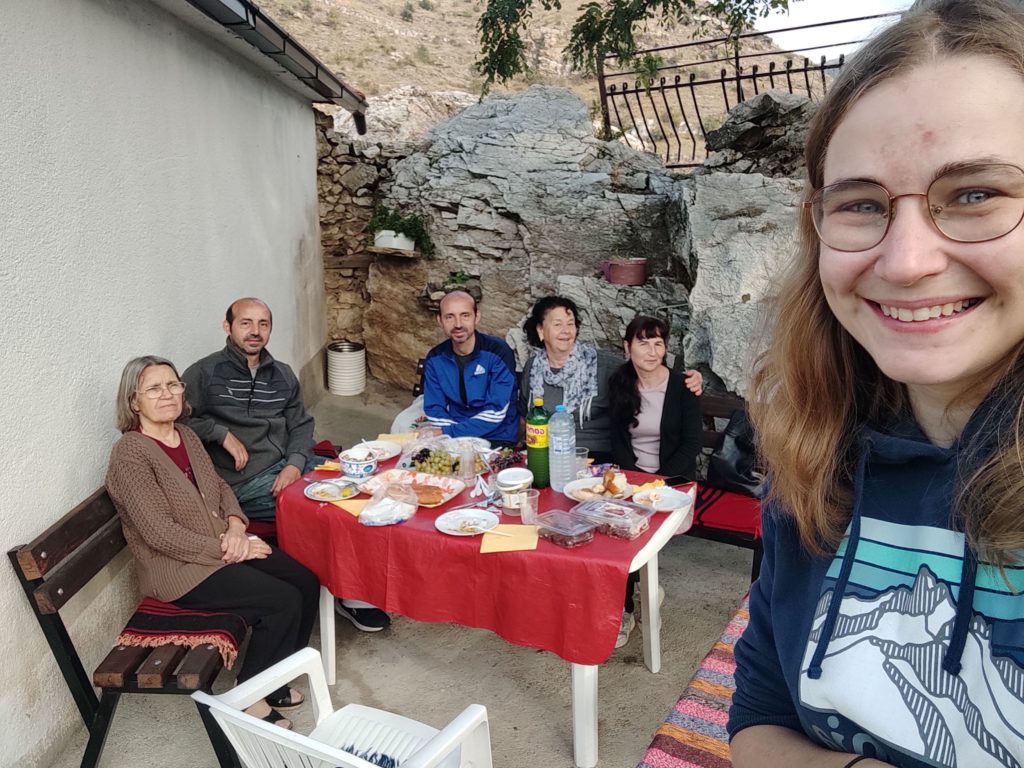
Looking for more information about cycling in the Balkans? Read my other articles:
The best long distance cycling routes to explore in 2025
Embarking on a long-distance cycling adventure is one of the best ways to explore the…
Cycling in Bosnia and Herzegovina – Practical Bike Touring Guide
Cycling in Bosnia and Herzegovina was my favourite part of the three-month-long solo trip around…
Cycling in Montenegro – practical bike touring guide
When I first came to Montenegro for a cycling holiday 12 years ago, I thought…
Cycling to Theth – The Most Stunning Bicycle Route in Albania
While the Alpe Adria and other scenic cycling routes in the Alps attract thousands of…
The Journey through History – Visiting Communist Sites in Albania
During the brutal communist regime of Enver Hoxha, Albania was the most isolated and inaccessible…
Things to do in Korçë – the most underrated Albanian city
Located on the peripheries, Korçë rarely makes it to the list of the best places…
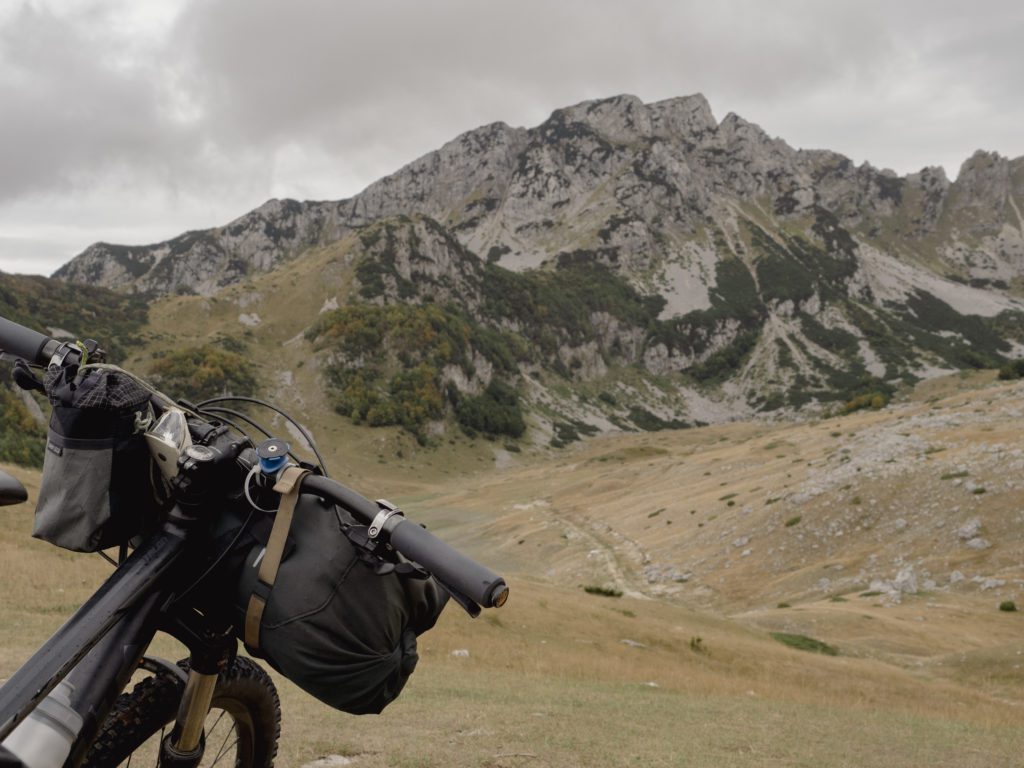
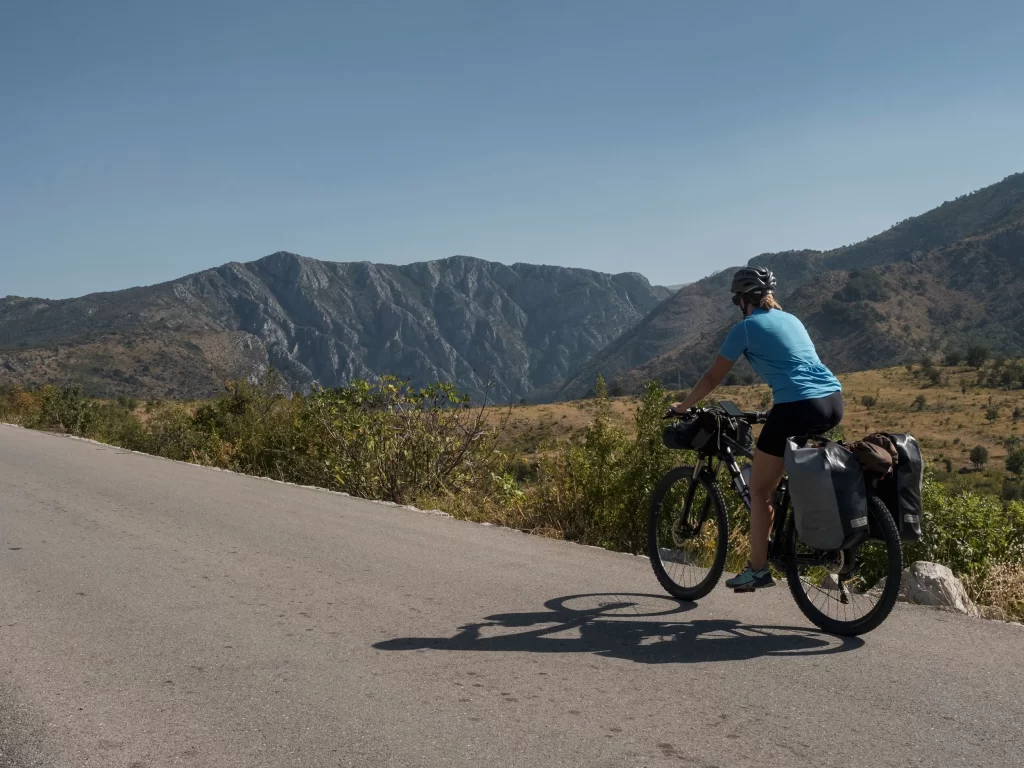
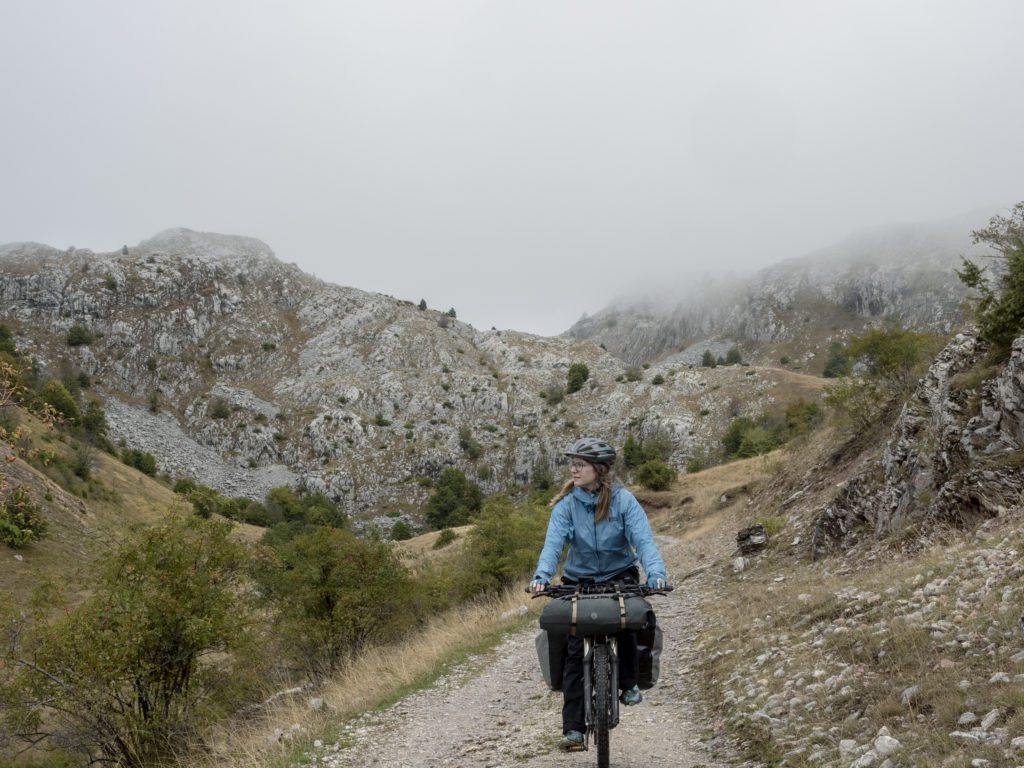
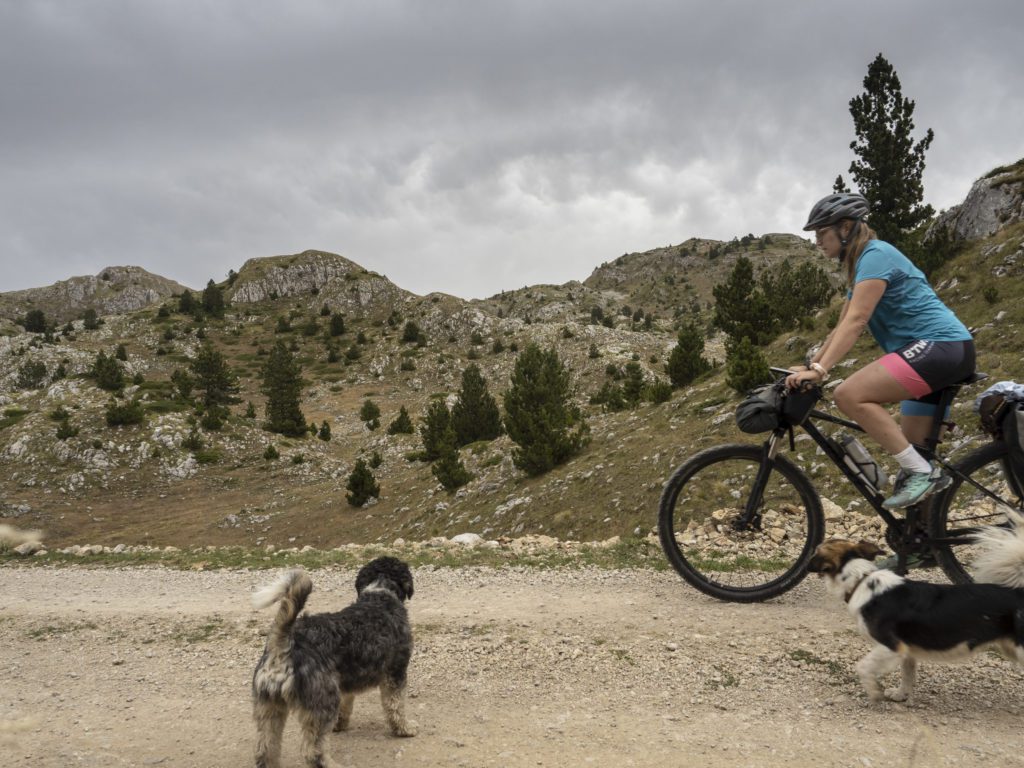
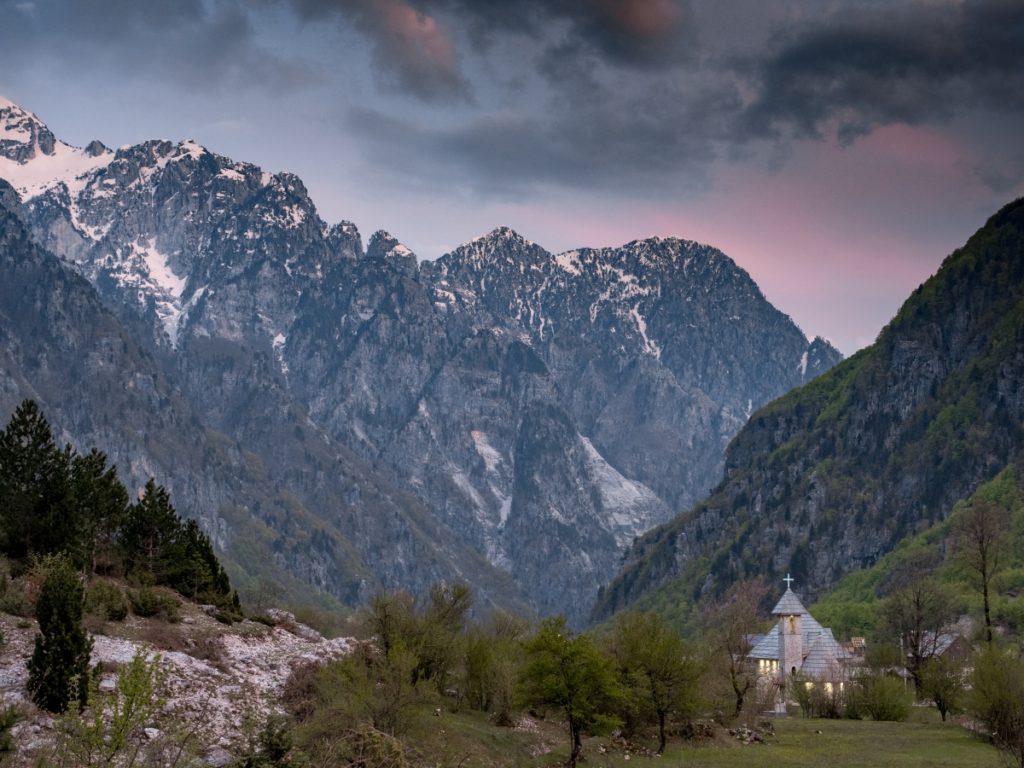
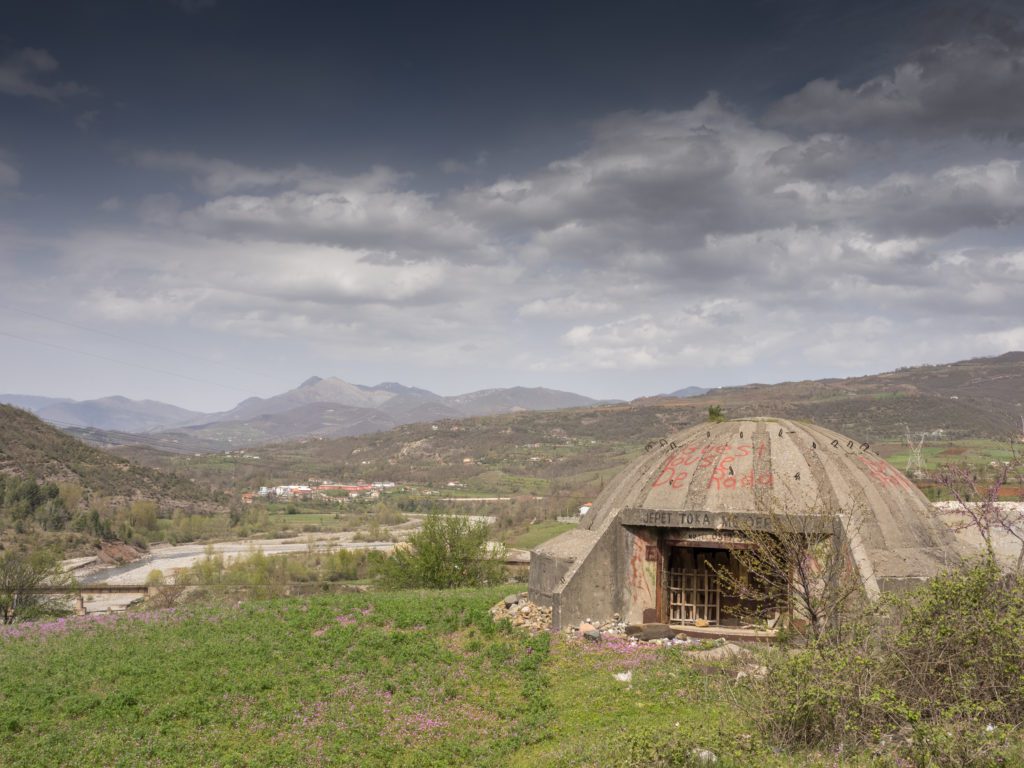

So did you actually pay the crazy fee for the gpx from your own pocket? I guess their marketing budget has to be paid from somewhere, they did a really great job with that.
Yes, I did pay for the gpx from my own pocket and I don’t believe the fee is crazy. There is a lot of work behind keeping the trail information up to date and accurate, the payment also helps support the community-based tourism in the region. And the number of POIs and useful information in the app makes life much easier. For me, it was definitely worth the money but if you think it’s too expensive, you can also use the information available for free on their website to navigate.
Thanks for your reply, and it’s a nice blog you got going here!
You have given a brilliant description of the trail, which I would like to do in its entirety this year. I have two questions: when would be the best time to start the ride, and what type of bike would you recommend?
Hi Darron, that’s going to be one hell of adventure! If you want to do the entire trail, I think it’s best to start mid-April (you’ll have to plan it smart and avoid the higher mountain passes for the first weeks though). About 80% of the trail is asphalt but there are some rougher gravel roads so the best choice would be a gravel or touring bike.